Purple Gallinule
A species of Swamphens, Also known as Yellow-legged Gallinule, Pond Chicken Scientific name : Porphyrio martinica Genus : Swamphens
Purple Gallinule, A species of Swamphens
Also known as:
Yellow-legged Gallinule, Pond Chicken
Botanical name: Porphyrio martinica
Genus: Swamphens
Content
Description People often ask General Info
Description
The purple gallinule is a medium-sized rail, measuring 26–37 cm (10–15 in) in length, spanning 50–61 cm (20–24 in) across the wings and weighing 141–305 g (5.0–10.8 oz). Males, averaging 257 g (9.1 oz) in mass, are slightly larger than females, at 215 g (7.6 oz) on average. An adult purple gallinule has purple-blue plumage that will shine green and turquoise when in good lighting. Adults also have a pale blue shield on their forehead, which connects with the red and yellow bill. Darkness or low light can dim the bright purple-blue plumage of the adult to make them look dusky or brownish, although the forehead shield color differentiates them from similar species such as common gallinules. Immature purple gallinules are a brown-bronze color, with purple feathers on chest, and the bill and forehead shield is pale in color. Juvenile birds are light brown with hints of green-bronze on the wings and back, and white under-tail coverts. Purple gallinules have long legs with long toes that help them walk onto of the floating vegetation, by distributing their weight. They have an anisodactyl toe arrangement that also helps them to cling to plant stems. Adults have bright yellow legs and feet, immatures have brown-yellowish legs and feet, and juveniles have brown legs and feet. When they fly, their legs hang down. They usually fly short distances. 
Size
36 cm
Colors
Brown
Black
Green
Yellow
Red
Blue
Purple
Life Expectancy
22 years
Nest Placement
Floating
Clutch Size
6 - 8 eggs
Incubation Period
1 brood
Number of Broods
20 - 23 days
Feeding Habits
Purple Gallinule are omnivores with diverse diets, feasting on plants—water lily family parts, seeds from sedges, and invasive species like water hyacinth—and animals, including spiders, mollusks, insects, worms, frogs, small fish, and bird eggs. Their ground-feeding behavior includes foraging for fruits, leaves, and tubers, both aquatic and terrestrial.
Habitat
Purple Gallinule primarily dwell in freshwater marshes that retain water year-round. They favor environments rich in aquatic vegetation, such as sedges, grasses, and emergent floating plants like American lotus and water lilies, vital for foraging and nesting. While breeding purple Gallinule require dense vegetation for nesting sites, nonbreeding birds may utilize more open areas including lakes, ponds, and wet fields. Across their varied range, these birds have adapted to a wide array of wetland habitats, from sea level to Andean altitudes as high as 13,385 feet.
Nest Behavior
Purple Gallinule constructs multiple nests but uses only one for egg-laying. Both sexes build the nest, with unclear selection roles. Nesting includes laying eggs, incubation, and moving hatchlings to auxiliary nests.
Nest Characteristics
Purple Gallinule builds nests either as loose collections of vegetation on water or anchored in reeds. The platform-like structures are cup-shaped, around 11 inches across and 3.5 inches deep, sometimes featuring a half-roof or ramp.
Dite type
Omnivorous
People often ask
General Info
Feeding Habits
Bird food type
Bird Feeder Type

Platform

Ground
Sounds
Call
Recording location: Peru
Call
Recording location: Venezuela
Call
Recording location: Venezuela
Behavior
Purple Gallinule generally exhibit deliberate and cautious movements while foraging, akin to cautious chickens with elongated legs navigating through marshlands. Their typical day involves meticulous search for food amongst marsh vegetation, which ranges from plant matter to small animals. Purple Gallinule display a notable tail-flicking behavior as part of their locomotion. They are also adept at running, swimming, and even diving—maneuvers they employ when startled. They are competent climbers and can take refuge in trees or shrubbery, utilizing their wings for balance. Juvenile purple Gallinules' humorous antics whilst mastering the art of treading on floating vegetation is a sight to behold, especially as they dramatically raise their wings for balance when hurrying to their parents' calls. Territorial disputes among adults can escalate into physical confrontations, involving erect postures, chasing, and rarely, pecking and kicking. These skirmishes are often loud and may end with one bird adopting a submissive stance. Males, in particular, might display a distinctive bowing gesture post-conflict. Purple Gallinule are seasonal monogamists within the U.S., zealously defending territories around 2.5 acres during the breeding season. When not breeding, they are non-territorial and may inhabit areas alongside the more dominant Common Gallinules, which they often share nesting grounds with.
Distribution Area
These birds are found in the southeastern states of the United States during the breeding season. They are resident species in southern Florida, the Gulf and Pacific coast of Mexico, parts of Central America, and the Caribbean. During the non-breeding season, they are found more inland in parts of Central America. They can also be found within South America during migration, and sometimes strays can be found as far north as Canada. The species' habitat is freshwater marsh with dense stands of vegetation. The species has the greatest pattern of vagrancy amongst rails, with individuals recorded as far west as California and the Galápagos Islands, as far north as Iceland and Labrador, as far south as Tierra del Fuego, and as far east as Great Britain, Portugal and Cape Verde. This species has been recorded in the Cape Province of South Africa twenty-one times. Most of the birds were juveniles, so it is very unlikely that a breeding ground will be established there. 
